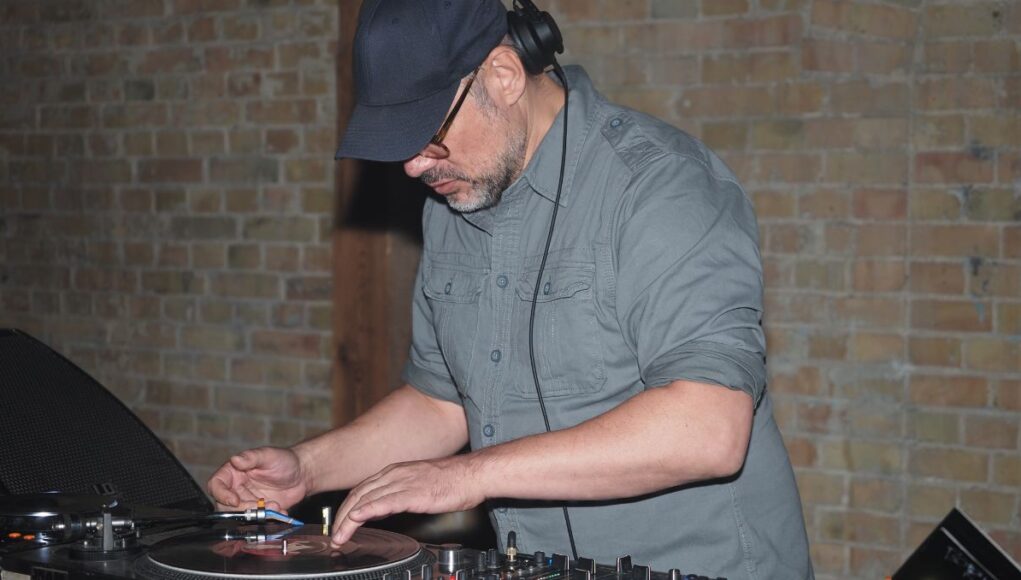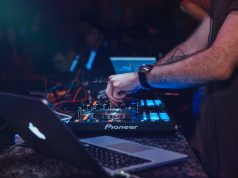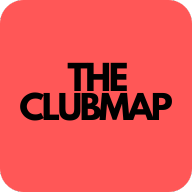The signs were there for a while. When I played, I instinctively chose early time slots and stayed outside the floors as much as possible so my ears wouldn’t close up. That I wasn’t hearing as well anymore… how hard it is to even write the word “hard of hearing”. It had long been obvious. My mother used to say it often and with a smile. Back then it was funny. Not anymore. I went to Geers for a test. After that, denial wasn’t an option.
“Do you work in a loud environment?” the audiologist asked.
“Yes, I’ve been DJing since 1992.”
The result was sobering: a knowing nod, a test chart with my curve at the bottom edge of the scale.
I used to think my son was too loud, but now it feels like I can barely understand him. He often gets annoyed when I have to ask again. When I’m out with friends, especially outdoors in summer, I often grab my phone because I can’t follow conversations anymore. In a world full of sound, it’s like a filter sliding slowly but relentlessly between me and everything else. And yet it all began with sound. With that one moment when you learn how to listen.
How It Started
I didn’t have my own 1210s at home back then. So I practiced on weekends at the club. Before the night started. For hours, whenever nobody was there. I picked records with long intros because I didn’t know how to mix yet. I heard the bass, the hi-hats, but it never fit. And then, after about six months, it happened: during a real set, two records synced. Perfectly. No pushing, no drifting. I stood there grinning. Oh my fucking God.
That was the beginning of everything.
I didn’t know anything about decibels, thresholds or frequencies. I just knew that volume equaled intensity. That you didn’t just want to hear music, you wanted to feel the bass. Which meant your Sennheiser headphones were turned up to MAX on the mixer just so you could hear anything at all. People shoved their damn heads into the speakers. In the nineties, tinnitus was a foreign word. We weren’t afraid of the roaring noise because it was our home. We loved it loud.
The Break
A few years ago it began… that numb feeling after one or two hours. Everything was too loud even though I was hearing worse. Which is why one-hour DJ sets used to be perfect. After that it became difficult.
The last time was this October at Revier Südost. I stood behind my son while he played his vinyl set. “He feels safer with dad,” he had said. Vinyl demands more than digital. But he’s good. He can do it. Still sweet.
Then I took over. And the disaster hit after the second record. I simply couldn’t hear it anymore. Cueing – matching headphones with the monitor – barely worked. But as soon as both channels ran on the floor, everything turned into noise. No way to tell if it fit. No way to tell what was even playing. I stood there like some clueless beginner idiot. I was embarrassed.
I’ve avoided getting hearing aids for two years since the diagnosis at Geers. But now my son and I are missing something important beyond gaming together (Elden Ring, Helldivers 2, Outriders, Warhammer and Battlefield 6). Buying tracks. Practicing at home. DJing together. So I asked myself what the hell is going on with my ears and whether a hearing aid could help me mix again. Many DJs go through something similar, even though almost no one talks about it openly. According to DJ Mag, up to 60 percent of professional DJs suffer from tinnitus or permanent hearing loss. “DJs often know far too little about the consequences of high noise exposure,” says Birgit Mazurek from the Tinnitus Center at Charité.
Long story short: a hearing aid can help, but not always in the way I need for DJing. AND if I turn myself up while mixing, I overload the residual hearing I have left. I don’t hear anything because it’s too loud, not because I suddenly went deaf. That’s called temporary threshold shift.
Modern hearing aids amplify specific frequency ranges, filter background noise, and match hearing curves. But: they optimize speech and everyday sound, not music. Many models also compress dynamics, which is counterproductive for mixing. Why?
Speech has a narrow dynamic range (around 30–40 dB from soft to loud). Music – especially electronic music – has a wide dynamic range and a complex harmonic structure. “Complex harmonic structure” means sound consists of bundles of additional frequencies: overtones and harmonics. A kick drum with a fundamental around 60 Hz also contains upper frequencies: attack, click, snare-like components, room reflections. When DJs cut mids or highs on the mixer, they’re not lowering “volume”, they’re removing frequency regions where most overtones and transients live.
Bass (below ~150 Hz) → fundamental, body (kick, sub)
Mids (approx. 200–4000 Hz) → presence, warmth, instrument recognition, voice
Highs (4 kHz and up) → overtones, attack, sharpness, spatiality
If you lose the overtones, all that remains is a muffled, undefined residue. It automatically feels quieter and further away. The new record can then cut in cleanly with its hi-hats or claps.
If your hearing loss affects high frequencies, you don’t perceive these overtones precisely anymore. Hi-hats, clap transients, or the click of a kick drum become indistinct. You can’t easily tell when two tracks are truly aligned. It becomes an acoustic grey zone where everything is there, but undefined.
Back to hearing aids. To make speech more intelligible, hearing aids use multiband compression: they split sound into frequency bands and reduce each one separately when it gets too loud. Great for cafés. Terrible for DJing.
Because when mixing:
– The bass gets dampened once the kick or sub hits
– Transients get flattened because the device treats them as “peaks”
– Your loud–soft relationship collapses
– Timing – essential for beatmatching – becomes unreliable
– And some devices add a small latency, which can throw you completely off beat
Some newer devices (e.g. Widex Moment, Phonak Audéo Lumity) include a “music mode” where compression is disabled or reduced. That preserves more dynamics and naturalness, but only works well if the environment isn’t extremely loud. Hearing aids also clip quickly when things get loud – which in a club ends in disaster.
What I Can Realistically Do. And You Can Too.
See an audiologist – but find one experienced with musicians (music medicine clinics or specialized audiologists). Get an audiometric profile. It shows exactly which frequencies are missing. In Berlin, Charité does this.
Ask about hearing aids with music modes (Phonak, Widex, Signia). These can be configured without compression and with low latency. Not perfect, but far better than standard devices.
Consider doing the actual mixing with adapted in-ear monitors (IEMs) with custom EQ mapping. There are IEMs tailored for hearing-impaired users – you get an “inverse profile” of your hearing curve. For DJs, brands like Audio-Technica (ATH-E70), Hörluchs, Ultimate Ears UE-6 Pro or Sennheiser IE 100 Pro are known for balanced frequency response and high headroom. Many come in custom-fit versions. See also: In-Ear Monitoring for DJs 2025.
Do a level reset. This always worked fairly well for me:
- Turn the booth monitors completely off.
- Use well-isolating headphones (AIAIAI, Sennheiser HD25 with sealed pads).
- Mix both channels using only the headset. Much cleaner.
- Tell the tech they don’t need to crank it louder.
- Use custom earplugs with 9 dB or 15 dB attenuation (Elacin, ACS). Mandatory if you want to keep your remaining hearing.
Where I Am Now
The brutal truth… If my hearing loss is severe, mixing will never be what it used to be. And I still remember that “bottom of the scale” chart from Geers very clearly. I could still DJ, just differently. With visual tools using waveforms, for example. Or I try the hearing aid first. If you have similar issues, ask your audiologist:
Can the device amplify music without dynamic compression?
(If not, the sound becomes flat and timing is impossible.)
What is the latency?
(Anything above 10–15 milliseconds makes beatmatching useless.)
Is there a music mode or programmable profiles?
(Good models like Widex Moment, Phonak Audéo Lumity, Oticon Real have this.)
How does the device behave at high volumes?
(Club levels can overload the input stage. Some devices clip.)
Can I fine-tune the device via app?
(You’ll need this to quickly adjust highs or disable limiting.)
Can I switch between profiles with one button?
(Ideal: Presets for Everyday / Studio / Club.)
Technical Features
Feature – Why It Matters
Wide frequency response (up to 10–12 kHz) – Crucial for hi-hats, transients and beatmatching
Music mode without compression – Otherwise dynamics and timing vanish
Low latency (<10 ms) – Essential for cueing
Manual volume / app control – So you’re not trapped mid-set
Streaming (Bluetooth LE Audio) – Optional, can help when producing
Deactivatable feedback management – Some devices kill transients
Custom-fit domes or earmolds – For stability and less outside noise
What Remains
Since two volunteers at our music demo “Zug der Liebe” suffered hearing damage five years ago, we’ve handed out ear protection to all stewards every year. I can’t get my hearing back, but I can stop others from losing theirs.
I know many people hesitate like I did. Hearing problems are something you cover up until it’s too late. You tell yourself it’s fatigue or stress. But eventually there’s only silence creeping into your life, and you’re constantly asking people to repeat themselves.
Hearing loss changes everything. Including your job. Every meeting becomes a nightmare. Especially online. Add English on top and you’re completely lost. In group rounds with teams or clients you nod through conversations without understanding a thing. In the end, life just passes you by.
Literatur & Fachquellen
- DJ Mag. (n.d.). Hearing damage: A DJ’s guide to preventing tinnitus. DJ Mag. Abgerufen von djmag.com/content/hearing-damage-djs-guide-preventing-tinnitus
- Bonedo. (n.d.). DJ Gehörschutz: Fakten, Tipps und Kaufempfehlungen. Abgerufen von bonedo.de/artikel/pflichtausstattung-gehoerschutz-fuer-djs-die-wichtigsten-fakten
- Professional Audiology. (n.d.). Musicians and Hearing Loss. Abgerufen von professionalaudiology.com/musicians-and-hearing-loss
- DWM Audiology. (n.d.). Musician Audiology and Custom Earplugs. Abgerufen von dwmaudiology.com.au/services/for-musicians
- DJ Lab. (2023). Neue UK-Studie zu Hörschäden von Clubgänger:innen. Abgerufen von dj-lab.de/neue-uk-studie-zu-hoerschaeden-von-clubgaengerinnen
- Cleveland Clinic. (n.d.). Noise-Induced Hearing Loss (NIHL): Symptoms & Treatment. Abgerufen von my.clevelandclinic.org/health/diseases/21776-noise-induced-hearing-loss-nihl
- American Tinnitus Association (ATA). (n.d.). Hearing Aids / Masking Devices. Abgerufen von ata.org/about-tinnitus/therapy-and-treatment-options/hearing-aids-masking-devices
- Humboldt-Universität zu Berlin. (2018). Hörgeräte. Technisierung der Wahrnehmung durch Rock. In: edoc.hu-berlin.de. DOI: 10.18452/xxx (Abrufbar über edoc.hu-berlin.de)








